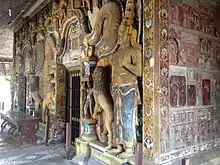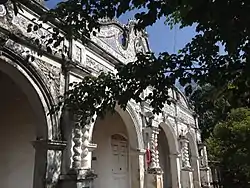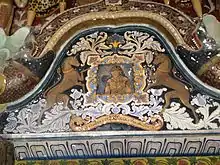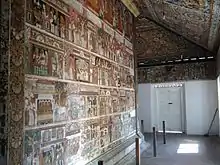Sri Subodharama Raja Maha Vihara
Sri Subodharama Raja Maha Vihara (Also known as Karagampitiya Vihara) is a historic Buddhist temple situated at Dehiwala in the Western province, Sri Lanka. The temple is located at the Dehiwala junction on the Colombo-Galle main road, about 9 miles south of Colombo city. The temple has been formally recognised by the Government as an archaeological site in Sri Lanka. The designation was declared on 23 February 2007 under the government Gazette number 1486.[1]
| Sri Subodharama Raja Maha Vihara | |
|---|---|
ශ්රි සුබෝධාරාම රජ මහා විහාරය | |
 The front wall of the inner chamber | |
| Religion | |
| Affiliation | Buddhism |
| District | Colombo |
| Province | Western Province |
| Location | |
| Location | Karagampitiya, Sri Lanka |
| Geographic coordinates | 06°50′56.0″N 79°52′05.9″E |
| Architecture | |
| Type | Buddhist Temple |
History
Background
In the early periods, Karagampitiya area was belonged to the Kingdom of Kotte and came under the region of Medimala (Nedimale). During the reign of king Parakramabahu VI (1412-1467) the Medimala village was gifted to the Natha Devalaya at Pepiliyana. The western area of the Medimala village was allocated to the fishing community and known as Karagampitiya as they supply fish to the royal palace.[2] In order to protect the fishermen from calamities and to safeguard the kingdom from foreign invasions, the king constructed a new Devalaya at the collum of a Na tree (Mesua ferrea) on a hillock at Karagampitiya.
During the Portuguese presence in the island, the Devalaya at Karagampitiya was destroyed and its stone pillars were used to erect the St. Anthony's church at Mount-Lavinia.[2] In between the period of Dutch (AD 1658–1796) in the island, a Dutch church and an Ambalama were built in the Karagampitiya area. It is said that the first incumbent of the Karagampitiya Vihara, Ven. Hikkaduwe Indrajothi thera have lived at that Ambalama. In 1881 during the period of British, the old stone pillars those were brought from the destroyed Devalaya to Dutch built church were again returned to the Karagampitiya temple when the Methodist church of Mt. Lavinia was built by British rulers.
The temple


The Buddha statues of the Vihara are dated back to the year 1780 and believed to be the creation of the same artist of Kelaniya Raja Maha Vihara.[2] In 1795 during the reign of king Rajadhi Rajasingha the construction of the Vihara work was completed and the work of the Stupa (Cetiya) was finished in 1796. As soon as the completion of the Vihara work, a plant from the Jaya Sri Maha Bodhi at Anuradhapura has been implanted in the premises. The preaching hall and the Sath-Sathi-Geya (A shrine room depicting the first seven week of Buddha) at the Vihara have been completed in the year 1895. The monastery of Subodharama at the Karagampitiya is believed to be established in the 1820s.[3][4]
Recent records about the Subodhara temple has been made in The Book of Ceylon written by Henry William Cave (1909) and in A New Model of the Universe by P D Ouspensky (1914).[2]
Temple layout
The layout of the Vihara consists of several sand terraces. The upper terrace is assigned for the Stupa and the Sath-Sath-Geya and the small chamber of Sri Pada (Foot print of Buddha) are located south to it. The image house is a rectangular building located at the center of the middle terrace and faces to south. To the west of the image house is the lower terrace where the Bodhi tree has been planted. The bell tower, Dhammasala (Preaching hall) and pilgrims' rest are also spread out on the lower terrace while the Awasa geya (Dwelling house of monks) is positioned on the south side, further away from them.
Murals


A large amount of paintings belonging to the Kandyan era adorn interior walls of many buildings in the Vihara complex. The earliest and also the main publication of these painting series are preserved on the three inner walls of the ambulatory of the image house.
The image house consists of an inner chamber (shrine room) surrounded by an outer shelter. The inner chamber opens towards the south direction and has two entrances, framed with sculpted Makara Thorana (Dragons arches). A portrait of the Queen Victoria has been painted over the right side entrance door in a framed portrait, accompanied by two unicorns. Also some Delftware fragments and VOC coins have been used to decorate the door surface as well as the floor of the image house.
The outer walls of the inner chamber contain a large number of narrative paintings arranged in five horizontal bands of nearly 26 inches in height.[4] These bands are adorned with various drawings related to the Buddhism. The upper most horizontal bands of the three walls are illustrated with proclamation of the twenty four Buddhas of the past while the lower band decorated with floral scrolls and lotus petal motif. The middle bands of the walls display the episodes from the life of the Gautama Buddha and Jataka stories. (Khadirangara Jataka, Nimi Jataka, Mahajanaka Jataka, Manicora Jataka and Katthahari Jataka). All the paintings show the features of conventional style of the hill-country (18th century) and the realistic style of the low-country (19th century).
The ceiling and the upper part of the outer walls of the ambulatory of the image house have also been covered with paintings done in 1897. The upper part of the outer wall represent the story of Maha Ummagga Jataka while Buddhist heavens are depicted on the ceiling panels.
See also
References
- Gazette 1486 & 23 February 2007, p. 7.
- Gunasekera, Kumudu (24 May 2013). "Temple of historical significance". Daily News (Sri Lanka). Retrieved 14 February 2017.
- Dissanayake, Aditha (8 October 2000). "Central Cultural Fund begins rescue work on photo archives". The Sunday Times (Sri Lanka). Retrieved 14 February 2017.
- Wijerathna, D.S./Ariadurai, S.A./De Silva, Nimal (16 July 2014). "Study on pictorial expression of the mural paintings at Subodharamaya temple murals of Karagampitiya, Dehiwala" (PDF). Open University of Sri Lanka. Retrieved 14 February 2017.
{{cite web}}: CS1 maint: multiple names: authors list (link)
Works cited
- "PART I : SECTION (I) — GENERAL Government Notifications" (PDF). The Gazette of the Democratic Socialist Republic of Sri Lanka. 1486. 23 February 2007.
Further reading
- Chutiwongs, Nandana; Prematilake, Leelananda; Silva, Roland (1990). Paintings of Sri Lanka - Karagampitiya. Colombo: Centenary publications.